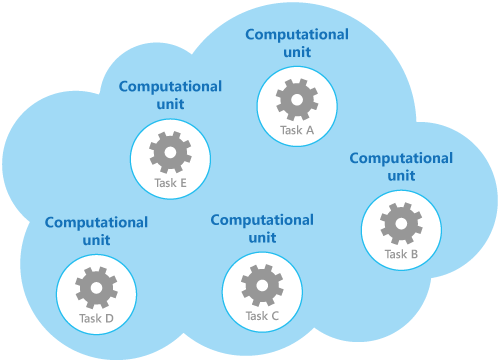A cloud application frequently implements a variety of operations. In some solutions it may make sense initially to follow the design principle of separation of concerns, and divide these operations into discrete computational units that are hosted and deployed individually (for example, as separate roles in a Microsoft Azure Cloud Service, separate Azure Web Sites, or separate Virtual Machines).
However, although this strategy can help to simplify the logical design of the solution, deploying a large number of computational units as part of the same application can increase runtime hosting costs and make management of the system more complex.
Each computational unit runs in its own virtual environment. E

Running tasks in a cloud environment by using a set of dedicated computational units
Each computational unit consumes chargeable resources, even when it is idle or lightly used. Therefore, this approach may not always be the most cost-effective solution.
To help reduce costs, increase utilization, improve communication speed, and ease the management effort it may be possible to consolidate multiple tasks or operations into a single computational unit.
Tasks can be grouped according to a variety of criteria based on the features provided by the environment, and the costs associated with these features. A common approach is to look for tasks that have a similar profile concerning their scalability, lifetime, and processing requirements. Grouping these items together allows them to scale as a unit.
The elasticity provided by many cloud environments enables additional instances of a computational unit to be started and stopped according to the workload.
As a counter example to show how scalability can be used to determine which operations should probably not be grouped together, consider the following two tasks:
The second task requires elasticity that may involve starting and stopping a large number of instances of the computational unit. Applying the same scaling to the first task would simply result in more tasks listening for infrequent messages on the same queue, and is a waste of resources.
If there are tasks that require a great deal of CPU power in short bursts, consider consolidating these into a single computational unit that provides the necessary power. However, it is important to balance this need to keep expensive resources busy against the contention that could occur if they are over-stressed. Long-running, compute-intensive tasks should probably not share the same computational unit, for example.
Use this pattern for tasks that are not cost effective if they run in their own computational units. If a task spends much of its time idle, running this task in a dedicated unit can be expensive.
This pattern might not be suitable for tasks that perform critical fault-tolerant operations, or tasks that process highly-sensitive or private data and require their own security context. These tasks should run in their own isolated environment, in a separate computational unit.